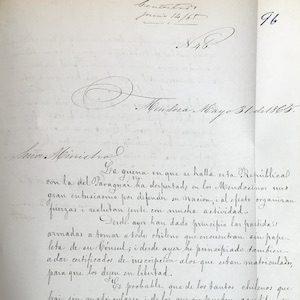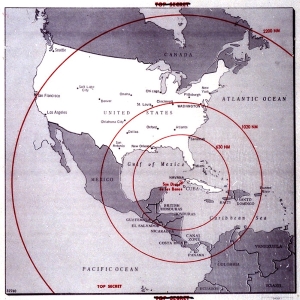War

Map of Europe, 1918
This map illustrates European borders prior to the start of WWI in 1914 with black lines and new states formed by the First World War in red. As the map illustrates, a number of states became independent from Tsarist Russia. What new states were these?

Original Manuscripts of Anne Frank
Born to a Jewish family in 1929, Anne Frank is most known for the diary she kept while in hiding from Nazi forces during World War II. The War broke out in 1939 when Anne was ten-years-old.
Primer: Transnational Mobility and State Formation
Modern nation-states and transnational mobility – the movement of people, things, and ideas across borders – are two important subjects for historians to study. They are two fundamental features of the modern world and have influenced one another constantly over the last several centuries.

Chilean Consul Writes of Immigrants Seeking to Avoid Military Service, 1865
This document is a portion of a letter, written by José de la Cruz Zenteno, the Chilean consul in Mendoza, Argentina to the Minister of Foreign Relations in Chile is from the National Archive of Chile. Mendoza was and is an Argentinian province that borders Chile.
Statute of the International Criminal Tribunal for Rwanda, 1994
Established in November of 1994 by Resolution 955 of the United Nations Security Council, the International Criminal Tribunal for Rwanda (ICTR) was intended to try those responsible from the Rwandan genocide ethnic Tutsi and politically moderate Hutu and other Rwandan violations of international
Statute of the International Criminal Tribunal for the former Yugoslavia
Established by United Nations resolution 827 of May 25th, 1993, the International Criminal Tribunal for the former Yugoslavia (ICTY) was a body with the purpose of prosecuting war crimes committed during the Yugoslav Wars and had jurisdiction over four groups of criminal activity committed since
Excerpt from the Kellogg-Briand Pact, 1928
Also known as the Pact of Paris, the Kellogg-Briand Pact of 1928 was an international agreement sponsored by the United States and France aimed to eliminate war as a means of conflict resolution on the international playing field following World War I.

Map of the Range of Nuclear Missiles in Cuba, 1962
Marking one of the most dangerous periods of the Cold War, the Cuban Missile Crisis began on October 16, 1962, when U.S. national security advisors alerted President John F. Kennedy that a Soviet missile base was under construction in Cuba.
Analyzing Official Documents
Official documents produced by governments, supranational organizations, courts of law, and more are abundant in supply, but can be intimidating and confusing to approach. They are often filled with language that seems convoluted, emotionless, and highly technical.

A Naval Encounter between Dutch and Spanish Warships
Spanish galleons were large ships specifically built to carry a huge amount of cargo across the vast distances of the Spanish maritime empire. The Manila Galleon Trade is a common topic in world history courses and represents the first truly global trade in world history.